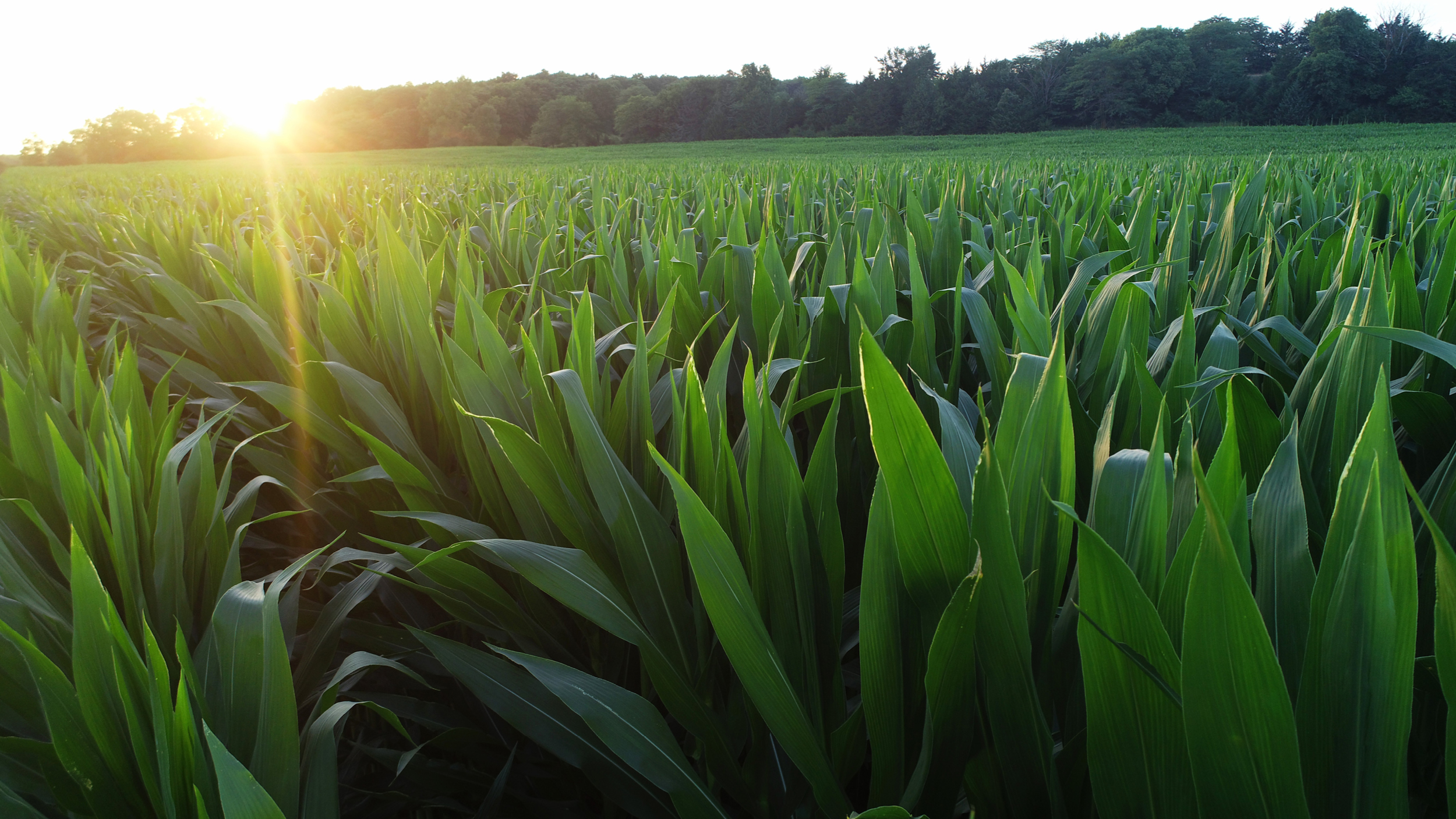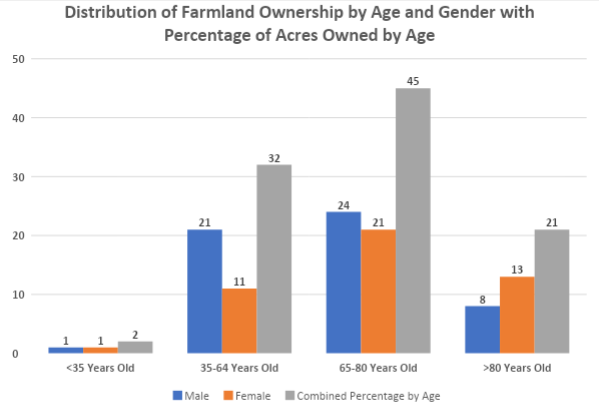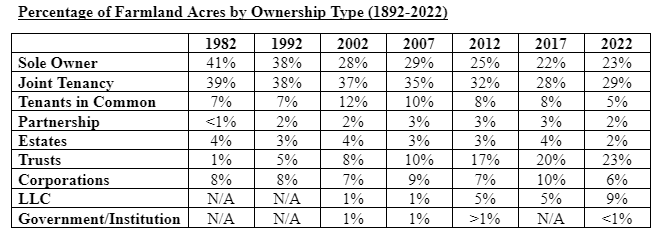
The recent Farmland Ownership and Tenure Survey 1982-2022: A Forty-Year Perspective survey was conducted by the Center for Agricultural and Rural Development (CARD) at Iowa State University. This study is conducted every five years on a state level and evaluates farmland ownership, tenancy, and transition of Iowa farmland combined with characteristics of farmland owners. Although the survey started in the 1940s, consistent survey results have occurred since 1989 with some of the most robust data for the last three decades as mandated by the state’s legislature.
From this year’s state-level study, five key trends were observed. These trends include the increase in the age of farmland owners, expansion of the overall number of acres cash rented across the state, financing of farmland, the change of ownership structure for farmland, and implementation of on-farm conservation practices.
The first trend is the continuation of aging farmland owners in Iowa. Two-thirds of all Iowa farmland is currently owned by people over the age of 65, which is 6% higher than in 2017 and nearly double the age of farmland owners in 1982. Furthermore, farmland owners who were 75 years of age or above owned a record 37% of all farmland acres in Iowa. The aging farmland owner is not unique to Iowa as many other agricultural-related states across the nation are experiencing similar trends and challenges. The U.S. Census of Agriculture has revealed aging farm operators, which is consistent with the aging workforce in nonagricultural sectors across the nation.

A second major trend is the increasing amount of land that is cash rented. Leased farmland was equally divided between cash rent and crop share leases back in 1982, but in 2022, nearly 90% of leased farmland was under a cash rental arrangement, covering a record percentage of 51% of farmland (42% of Iowa farmland is leased out via fixed cash rental contracts with 9% structured as flexible cash rental contracts). This rise in cash rent arrangements is a result of a decrease in owner-operated land and leasing via crop share arrangements, as regions with higher quality soil ratings typically have higher cash rent arrangements and larger percentages of absentee landowners.
The third major trend observed is that 84% of Iowa farmland was owned debt-free, a significant increase from 62% in 1982 and 82% in 2017. This is a result of recent hikes in commodity prices, aging landowners combined with longer terms of ownership. It is also related to record-high government payments during the COVID-19 pandemic. However, the financing situation is unique across the different age cohorts of landowners. Landowners 65 years old or above have at least 90% of the land they own fully paid for, but the debt-free percentages for landowners in the bottom two age demographics (younger than 35 and 35 to 64 years old) are only 17 and 70% of their owned land, respectively. The high debt-free status of Iowa farmland ownership is consistent with the increasing relevance of family or sentimental reasons for owning land. Over one-third (37%) of farmland is owned primarily for family or sentimental reasons.
The fourth notable trend is the continued shift away from sole ownership and joint tenancy to more institutionalized ownership structures such as trusts and corporations. Trusts accounted for 23% of all farmland acres, whereas three decades ago almost no land was owned in that sort of entity. Nearly two-thirds of trusts are in the form of revocable living trusts. In addition, corporations and LLCs account for 6 percent and 9 percent of farmland ownership, respectively. In contrast, farmland owned by sole owners or joint tenancy has declined from 80% in 1982 to nearly only 50% in 2022.
Although the survey results (shown below) are from the recent Iowa farmland survey, the change in the structure of ownership from the mid-1980s to the present is consistent across the nation.

As a result of statewide efforts placed on the 2013 Iowa Water Quality Initiative and other initiatives across other Corn Belt states, conservation practices have been steadily adopted on-farm by farmers. Currently, 7% of Iowa’s farmland is growing cover crops, which is nearly double the acres in 2017. This may be the result of collaborative efforts between private entities, public universities, and land managers assisting landowners with these conservation efforts. Furthermore, 30% and 41% of Iowa farmland acres use no-till and reduced tillage practices. The use of edge-of-field conservation practices, such as saturated buffers, bioreactors, or water quality-enhancing wetlands are additional opportunities for future conservation practices.
All these observed trends have significant implications for when and how farmland is intended to be transferred to the next generation. Some of the most popular methods to transfer farmland to the next generation include willing/giving the land to family members (47%), transferring land through a trust (26%), or transferring assets through a business entity (12%). However, the survey found that over 80% of Iowa’s farmland is owned by someone that does not intend to sell, which shows the strong emotional connection to the land and pride of being an American Farmland Owner.
Three out of every four landowners (75%) are willing to sell land to hardworking, quality beginning farmers at fair market value, but dropped to only two out of every five landowners (40%) when offered below fair market value. Over half of the current landowners expressed concerns about the challenge of finding quality beginning farmers combined with their ability to pay current market values for farmland.
The agricultural economy in Iowa and across the Midwest faces both substantial opportunities and challenges over the next few years. However, the importance of the agricultural sector producing a safe, wholesome, and sustainable food supply is paramount to our daily lives and must also remain viable for the next generation.
Key takeaways from the forty-year perspective of farmland ownership survey include:
- Eighty-four percent (84%) of Iowa’s farmland is owned free of debt, which is a significant increase from 62% from the first survey in 1982 and an increase from 2017 (82%).
- Two-thirds of farmland is owned by people 65 years or older with over one-third (37%) of the total farmland owned by someone 75 years or older. Whereas the original 1982 survey that found only 29% of farmland was owned by people 65 years or older.
- Over 46% of Iowa’s farmland is currently owned by women of which 13% of the land is owned by females over 80 years of age.
- Fifty-eight percent (58%) of farmland is leased, with most leases structured as either fixed or flexible cash rental contracts. A fixed cash rent was the most popular lease method (42%).
- Thirty-seven percent (37%) of Iowa farmland is primarily owned for family or sentimental reasons, which is an 8% increase from 2017.
- There is a change of farmland ownership from sole ownership and joint tenancy to trusts, corporations, and LLCs, which accounted for 23, 6, and 9 percent of the land, respectively.
- Over half (55%) of Iowa farmland is owned by someone who does not currently farm, while 53% of the non-farming owners do not have any farming experience.
- One-fifth (20%) of Iowa farmland is owned by someone who is not an Iowa resident, which is up from 13% in 2017. Of the non-resident landowners, 70% do not have farming experience.
- Three of every four landowners in Iowa are willing to sell land to beginning farmers if incentivized with federal and state tax credits. However, there are challenges in finding quality beginning farmers and their limitations to pay top market values for farmland.

.jpg)







